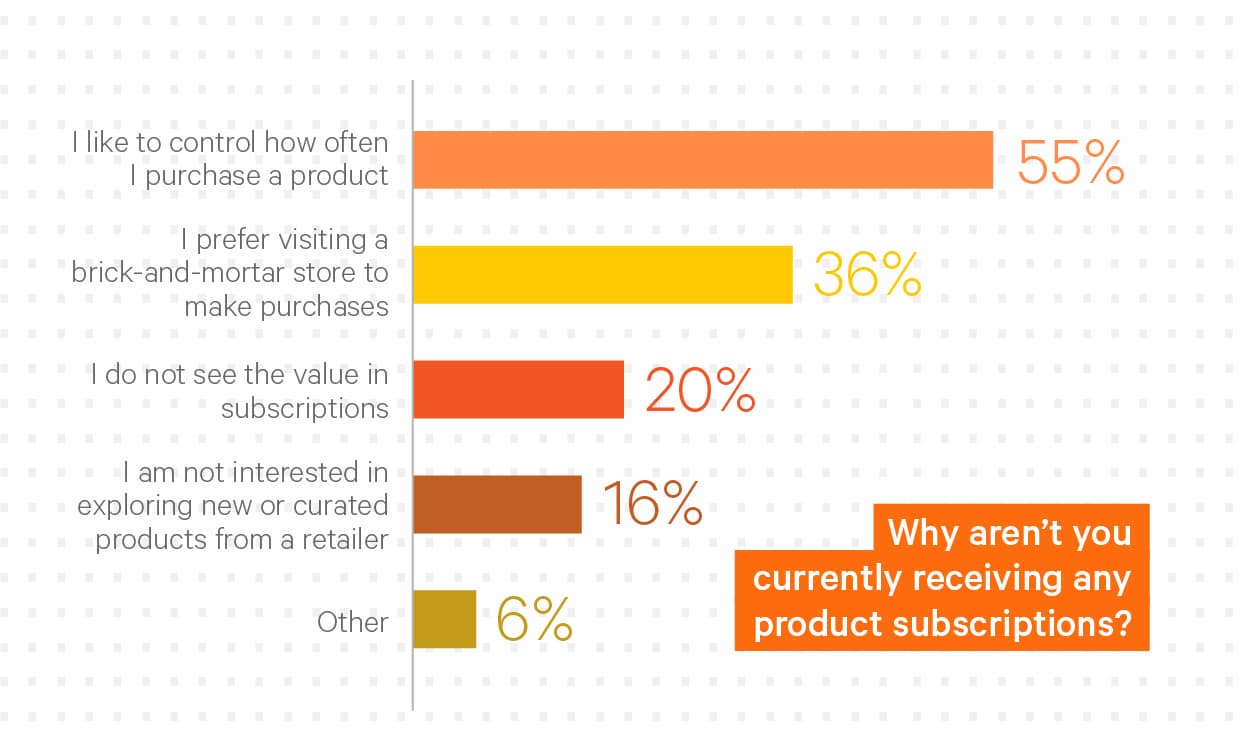Newspapers have been using the subscription business model for decades, and only in the last decade has the subscription model expanded into products. From dog food and razor blades to clothing and wine, subscriptions have made their way into many aspects of our everyday lives.
While there’s a subscription for products across nearly every category, not every consumer has bought into the subscription craze. Kibo surveyed of over 1,000 US consumers to ask about their product subscription behaviors, and we found that 64% of US consumers don’t have a product subscription.

If done right, retailers can tap into these consumers with a subscription business model that clearly demonstrates value and aligns with their expectations.
In this article, we’ll outline who subscribes and why, what’s stopping consumers from signing up for product subscriptions, and how the right subscriptions management platform can help convert the subscription skeptics.
Who’s signing up for product subscriptions
Before launching a subscription offering, it’s critical to understand your target audience so you can better market to those consumers and create an experience that meets their needs. Kibo’s subscription survey found which product subscription categories consumers prefer broken down by generation, household size, and children versus no children.
Generational:
The top three categories the Silent Generation is interested in are Health & Wellness, Home Goods, and Pet Care. However, the survey also found that 63% of these consumers are not interested in signing up for a product subscription in the future—the highest percentage among all generations.
The later generations are most interested in:
- Baby Boomers: Food & Beverage, Health & Wellness, and Beauty & Personal Care
- Gen X: Food & Beverage, Beauty & Personal Care, and Pet Care
- Millennials: Food & Beverage, Health & Wellness, and Beauty & Personal Care
- Gen Z: Beauty & Personal Care, Food & Beverage, and Health & Wellness
It’s important to note that, according to Kibo’s survey, the younger the generation, the more likely they are to be interested in subscribing to a product across all categories. Only 6% of Gen Z and 18% of Millennial survey respondents said they wouldn’t be interested in signing up for a product subscription in the future.
Household size:
When looking at household data, we found that the more people the respondent has in their household, the more likely they are to be interested in subscribing to a product subscription in the future. For example, 38% of single household respondents said they weren’t interested in subscribing to any of the listed product categories in the future, while only 9% of respondents with five or more household members said the same thing.
As the household size increases, these consumers are more likely to look for more convenient and cost-effective ways to purchase items—making subscriptions an attractive alternative to in-store shopping or one-time online purchases that don’t offer recurring discounts.
Children versus no children:
Overall, respondents with children are more interested in signing up for a product subscription than those without children. Respondents with no children are most interested in Food & Beverage, Health & Wellness, and Pet Care subscriptions. Respondents with children are most interested in Beauty & Personal Care, Food & Beverage, and Health & Wellness.
What consumers look for in each subscription type
There are three types of subscriptions: Replenishment, curation, and access. Just as the name suggests, replenishment subscriptions allow shoppers to purchase the same item on a recurring basis. When asked why they signed up for a replenishment subscription, 71% of respondents said for its convenience, 52% said they didn’t want to run out of a particular item, and 45% said they wanted to save money.
Curation subscriptions involve sending customers a curated box of products on a regular basis, often based on a previously filled-out questionnaire or specified preferences. When asked why they signed up for a curation subscription, 62% of respondents said it was because they wanted to try new products, 51% said it was for convenience, and 49% said they wanted to save money.
Access subscriptions require shoppers to pay a monthly, quarterly, or yearly fee to access exclusive perks, products, or discounts. When asked why they signed up for an access subscription, 63% of respondents said it was convenient, 46% said to save money, and 35% said they wanted to try new products.
Why shoppers don’t sign up for product subscriptions
As part of Kibo’s subscriptions survey, we asked respondents with no product subscriptions “why not?”

Lack of control: 55% of respondents said they chose not to sign up for a product subscription because they like to control how often they purchase a product.
Prefer shopping in-store: 36% of respondents said they prefer visiting a brick-and-mortar store to make purchases.
No value: 20% of respondents don’t see the value in product subscriptions.
Not interested in new products: 16% of respondents are not interested in exploring new or curated products from a retailer.
With a modern subscription management platform, you can overcome many of these hurdles.
Turn subscription skeptics into loyalists with the right subscriptions management platform
As you’re exploring subscription management platforms, it’s critical to find a solution that aligns with your business and customer needs. What features does your business need to successfully drive revenue with subscriptions, and what features do your customers need to have a valuable, frictionless subscription experience?
We’ve outlined six ways to effectively manage your subscription offering and provide an optimal subscription experience with the right solution.
- Control your subscription strategy
With a modern subscriptions management platform, you can fully control your subscription strategy—including choosing which products customers can subscribe to, complex pricing and discount rules, frequencies, and trials. This level of flexibility allows you to continuously evaluate your strategy and evolve your subscription business model as business needs and customer expectations change.
- Clearly demonstrate the value
Without clearly outlined benefits, it won’t be easy to convince shoppers to sign up for a subscription. By presenting the key benefits throughout the customer journey, including social media channels, eCommerce site, and emails, your customers can feel confident that they’re getting value from their subscription.
And with a solution like Kibo’s subscriptions management platform, you can try different combinations of pricing, discounts, and other offerings to find the right mix that will attract your target audience.
- Create a convenient experience with self-management
As we mentioned earlier, some consumers dislike subscriptions due to the lack of control. Giving shoppers the ability to pause or cancel, change frequency, update payment type, and swap products eliminates the perception that subscriptions are restrictive. This can also help minimize voluntary churn since customers can customize their subscription experience based on their needs.
Once you have self-management in place, use this as a value prop in your marketing messaging to entice shoppers to sign-up for your subscription offering.
- Empower customer service representatives
By empowering customer service representatives with the ability to see customer profiles and edit subscriptions, they can quickly resolve customer issues. Not only does this improve customer satisfaction, but it also saves the company time and resources.
- Create a frictionless checkout experience
Too often we see eCommerce sites redirect their customers to another window or website to complete the subscription sign-up process—resulting in a clunky experience and increasing the risk of dropoff.
But with an enhanced subscription management platform, such as Kibo’s subscription management solution, you can seamlessly integrate the subscription sign-up with your checkout flow for a frictionless experience.
Unless your entire business model is based on subscriptions, it’s critical to look for a subscription management platform that can support mixed cart experiences. This means allowing shoppers to add both product subscriptions and one-time purchases to their cart and to complete their purchase in the same checkout experience.
- Get the subscription order to the shopper on time
Can your order management system handle recurring orders and ensure the customer receives their order on time? And if a customer chooses to order their product subscription now instead of waiting until the next scheduled shipment, how quickly can your system turn that subscription into an order? These are some scenarios you need to consider when evaluating subscription management platforms and how they work with your order management system.
Ready to learn more about Kibo Subscriptions Management? Schedule a demo with a member of the Kibo team to see how the solution works and can fit into your customer experience.

Infographic: State of Product Subscriptions 2022




